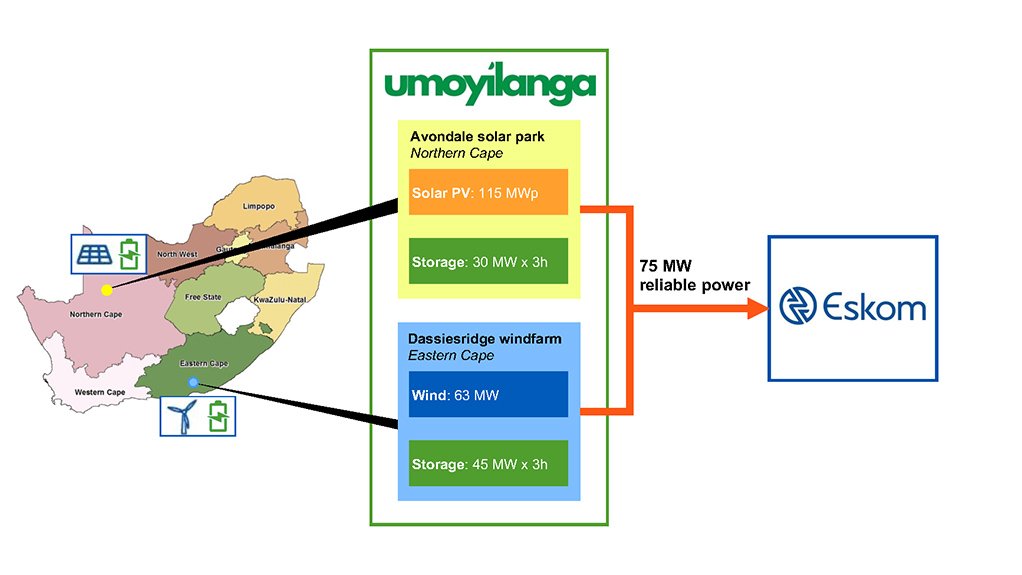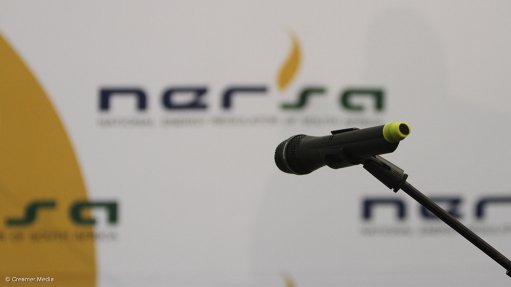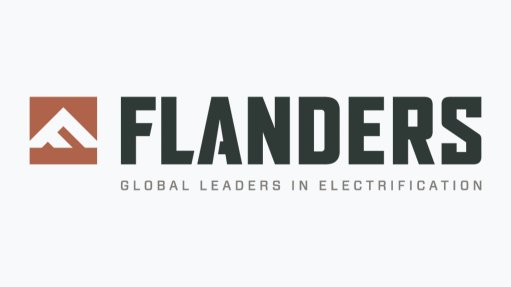75 MW Umoyilanga hybrid project reaches financial close under much-delayed risk-mitigation round
The Umoyilanga hybrid renewables-battery project, which will supply 75 MW of dispatchable electricity daily from 05:00 to 21:30 when built, has officially achieved financial close and is expected to begin commercial operation in March 2025.
The project is being developed by EDF Renewables and Perpetua Holdings, with financial backing from Nedbank, Rand Merchant Bank and the Development Bank of Southern Africa.
Bid under government’s much-delayed and heavily criticised Risk Mitigation Independent Power Producer Procurement Programme (RMIPPPP), the project will combine solar, wind and battery storage technologies across two sites to produce electricity in line with a 20-year power purchase agreement (PPA) signed with Eskom on August 30.
The project was named as a preferred RMIPPPP bidder in March 2021, along with other hybrid projects and the proposed Karpowership gas-to-power floating plants.
Since then, however, only Scatec’s three hybrid projects have entered construction, with the powership projects having met legal resistance from a competitor and having fallen short in meeting South Africa’s environmental regulations. Karpowership has since received approvals at two sites, but is facing an appeal on at least one site.
The Umoyilanga project, the group adds, will operate as a virtual power plant, combining generation from two sites which are 900 km apart.
The sites are Avondale in the Northern Cape, where 115 MW of solar photovoltaic (PV) and 30 MW of battery storage will be installed, and Dassiesridge in the Eastern Cape, with 63 MW of wind and 45 MW of battery storage.
To achieve the dispatchable profile outlined in the PPA, the batteries at Dassiesridge will charge from the wind energy at night, discharging power in the morning until the sun rises.
The solar installation at Avondale will supply the bulk of the energy during the day, supplemented by wind energy from Dassiesridge. Excess solar energy will be used to charge the batteries at Avondale, which will discharge after sunset.
A sophisticated energy management system will give instructions to assets across both sites to optimise the power supply in real time, depending on weather forecasts and Eskom’s requirements.
EDF Renewables reports that early works have started on the sites and that the construction phase will now begin.
A turnkey engineering, procurement and construction agreement has been signed with China Energy Engineering Corporation to proceed with the final design, procurement and construction of the 115 MW Avondale PV plant, while a turbine supply and installation agreement has been concluded with Vestas to proceed with the erection of 14 wind turbines of 4.5 MW on Dassiesridge.
A wind balance of plant contract has been signed with Power Construction and Adenco Construction, to build all required infrastructures on Dassiesridge, and a battery energy storage system supply agreement is in place with Sungrow Power Supply, to deliver the battery systems at both sites.
EDF Renewables says the electricity is equivalent to the demand of 120 000 households, based on the Eskom residential consumption average of 3 319 kWh/household.
The project will provide around 890 job-year opportunities during construction, during which more than 40% of the capital expenditure will be used to procure local goods and services.
Over the 20-year operational period, 1% of revenue will be dedicated to local communities through socio-economic initiatives.
Article Enquiry
Email Article
Save Article
Feedback
To advertise email advertising@creamermedia.co.za or click here
Comments
Press Office
Announcements
What's On
Subscribe to improve your user experience...
Option 1 (equivalent of R125 a month):
Receive a weekly copy of Creamer Media's Engineering News & Mining Weekly magazine
(print copy for those in South Africa and e-magazine for those outside of South Africa)
Receive daily email newsletters
Access to full search results
Access archive of magazine back copies
Access to Projects in Progress
Access to ONE Research Report of your choice in PDF format
Option 2 (equivalent of R375 a month):
All benefits from Option 1
PLUS
Access to Creamer Media's Research Channel Africa for ALL Research Reports, in PDF format, on various industrial and mining sectors
including Electricity; Water; Energy Transition; Hydrogen; Roads, Rail and Ports; Coal; Gold; Platinum; Battery Metals; etc.
Already a subscriber?
Forgotten your password?
Receive weekly copy of Creamer Media's Engineering News & Mining Weekly magazine (print copy for those in South Africa and e-magazine for those outside of South Africa)
➕
Recieve daily email newsletters
➕
Access to full search results
➕
Access archive of magazine back copies
➕
Access to Projects in Progress
➕
Access to ONE Research Report of your choice in PDF format
RESEARCH CHANNEL AFRICA
R4500 (equivalent of R375 a month)
SUBSCRIBEAll benefits from Option 1
➕
Access to Creamer Media's Research Channel Africa for ALL Research Reports on various industrial and mining sectors, in PDF format, including on:
Electricity
➕
Water
➕
Energy Transition
➕
Hydrogen
➕
Roads, Rail and Ports
➕
Coal
➕
Gold
➕
Platinum
➕
Battery Metals
➕
etc.
Receive all benefits from Option 1 or Option 2 delivered to numerous people at your company
➕
Multiple User names and Passwords for simultaneous log-ins
➕
Intranet integration access to all in your organisation





















